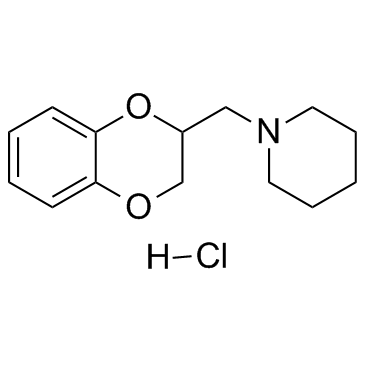135-87-5
| Name | 1-[(2,3-dihydro-1,4-benzodioxin-2-yl)methyl]piperidinium chloride |
|---|---|
| Synonyms |
1-(1,4-Benzodioxan-2-ylmethyl)piperidine hydrochloride
Benzodioxane hydrochloride Benodaine hydrochloride EINECS 205-222-3 933F Hydrochloride 933F 2-Piperidinomethyl-1,4-benzodioxan hydrochloride 1,4-Benzodioxan,2-(1-piperidylmethyl)-,hydrochloride 2-(1-Piperidylmethyl)-1,4-benzodioxan hydrochloride Piperoxan hydrochloride Piperoxan (hydrochloride) |
| Description | Piperoxan hydrochloride is an α2 adrenoceptor antagonist. |
|---|---|
| Related Catalog | |
| Target |
adrenoceptor[1] |
| In Vitro | When the medulla is superfused with α2 adrenoceptor antagonist Piperoxane (50 μM; 5 min) while the pons is with artificial cerebrospinal fluid (ACSF), the three inactive preparations display rhythmic phrenic bursts at a low frequency (2-4 c/min), and the phrenic burst frequency of the 12 active ones significantly increases during the last 3 min of Piperoxane applications (163±12% of the previous mean frequency). In active medullary preparations, the effects of NA applications (25 μM; 5 min) are compared when the preparations sre superfused either by ACSF (n=8) or by the α2 adrenoceptor antagonist Piperoxane (50 μM; PIP-ACSF; n=5). NA applications either alone (NA-ACSF) or with Piperoxane (PIP-ACSF+NA) significantly increases the phrenic burst frequency. However, the blockage of the medullary α2 adrenoceptors by Piperoxane potentiates a phrenic burst frequency increase: during the fifth minute of NA applications, the phrenic burst frequency reached 171±11% of the mean control value when ACSF is applied alone and 234±21% of the mean control value when PIP-ACSF is applied in control condition[1]. |
| Kinase Assay | The mouse neonates (P0-P3) are ether-anesthetized and decerebrated; the brain stems and the cervical spinal cords are dissected out and placed ventral sides up in a 2 mL chamber superfused with artificial cerebrospinal fluid (ACSF) at 27±0.25°C (mean±SD), renewed at a rate of 2 mL/min. The ACSF [containing (in mM) 129 NaCl, 3.35 KCl, 1.26 CaCl2, 1.15 MgCl2, 21 NaHCO3, 0.58 NaH2PO4, and 30 glucose] is oxygenated and equilibrated (pH 7.4 at 27°C) by bubbling carbogene (95% O2-5% CO2). In the pharmacological experiments, this is replaced by another ACSF in which bioreactive substances are dissolved: noradrenaline at 25 μM (NA-ACSF) or α2 adrenoceptor antagonists, either Piperoxane at 50 μM (PIP-ACSF) or yohimbine at 50 μM (YO-ACSF). In some of the experiments, a patch-clamp microelectrode (1 μm diameter tip) is lowered within the ventral pons into the A5 nucleus where a solution of either ACSF or NA (1 mM) is pressure-ejected. The ejected volume is estimated 20 nL for a pressure pulse lasting 2 s[1]. |
| Animal Admin | Mice[2] Male Balb-C mice are used, weighing between 20 and 25 g. In mice pretreated with the α-adrenoceptor antagonist Piperoxan, or with naloxone, both at a dose of 3×10-5 mol /kg s.c. given 15 min before the acetic acid, the antinociceptive action of (-)-isoprenaline is only slightly antagonized. Dose-ratios of 1.45 and 1.7, are produced by these two antagonists. |
| References |
| Density | 1.113g/cm3 |
|---|---|
| Boiling Point | 331.5ºC at 760mmHg |
| Molecular Formula | C14H20ClNO2 |
| Molecular Weight | 269.76700 |
| Flash Point | 118.1ºC |
| Exact Mass | 269.11800 |
| PSA | 21.70000 |
| LogP | 3.05220 |
| Vapour Pressure | 0.000155mmHg at 25°C |
CHEMICAL IDENTIFICATION
HEALTH HAZARD DATAACUTE TOXICITY DATA
|
